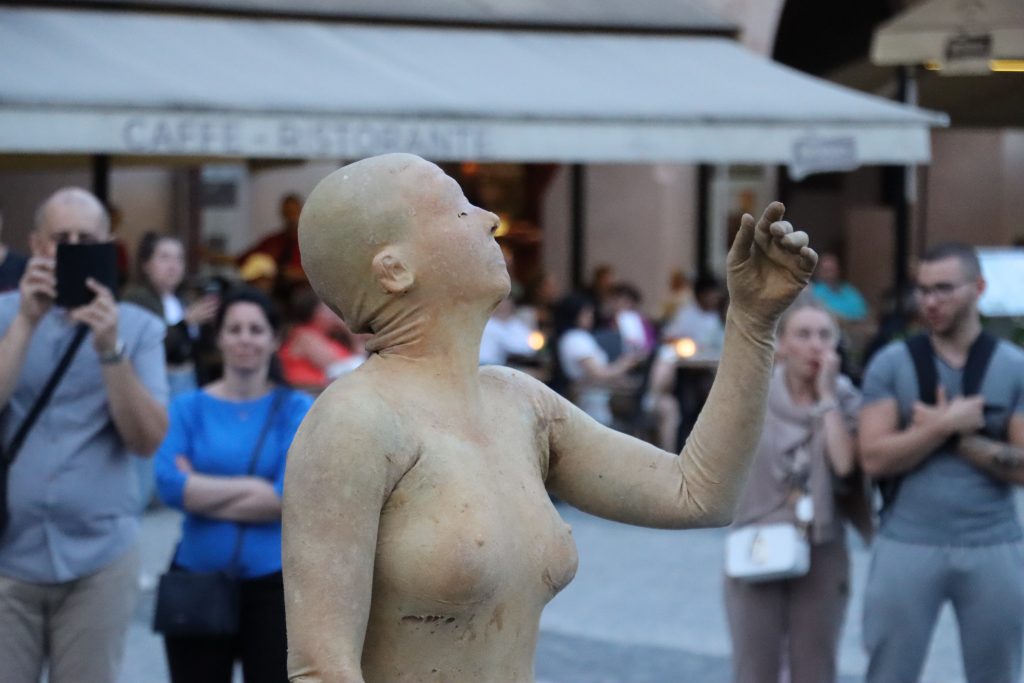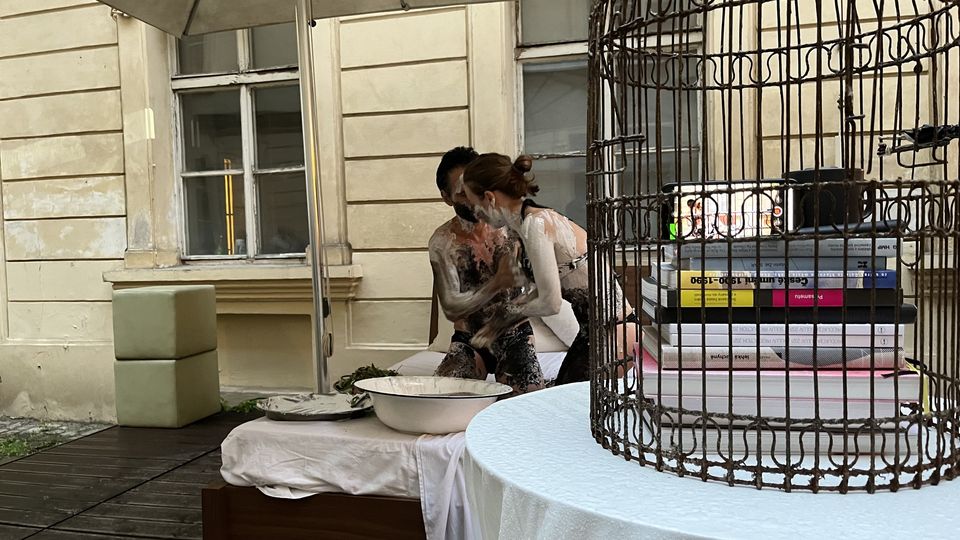Re-connect Art, an international performance and multimedia festival, is an offspring of the Prague Biennale, inaugurated at Prague’s National Gallery under the vision and co-direction of Flash Art in June 2003. Therefore, to celebrate the 20th anniversary of the Prague Biennale which was discontinued after the 2013 edition, Re-connect Art keeps this spirit going with 81 artists from 17 countries taking part in it over a two-week period.
Curated by Jitka Hlaváčková and Elis Unique, this year’s third edition of the annual festival was subtitled “The Virtual Body of Society”. Located in galleries and public spaces (including some tourist-heavy spots), it boldly prodded the public to connect (sometimes virtually).
The main attraction in the Prague City Gallery’s Stone Bell House was a dissection of the body informed by medical practices spanning from alchemic to modern. “Futura spagyrica” by performance artists Verena Stenke and Andrea Pagnes (aka VestAndPage) transformed rooms into magical chambers or realms of senses throughout the cellar, illuminating on the mysteries of the Head & Brain, Bones (and spaces between the joints), Vocals, Blood, the Skeleton, Lungs, and the Spirit. Glass jars for strange mixed powders and chemicals pointed to the healing principles of the spagyrica practice, referring to Prague’s era of Emperor Rudolf II. The Vocals room emitted an eerie low-screaming voice from a video showing the insides of the throat, while the Blood room had sounds of a thumping heart with video footage of it resembling a volcano erupting with fire and torrents of lava.
The Lungs room had a video of Stenke and Pagnes doing mouth-breathing exercises with a narrator giving a scientific explanation of the chemical processes involved. With their heads encased in glass, they tried to touch or kiss, but were kept apart by the glass while the narrator chanted: “Catch my breath, took my breath away, in-spire, ex-spire, spirit – mana – pneuma – atum – ruach – anima.” This project’s aim of exploring the fragility of life (our internal machinery) with curiosity and experimentation was enlightening.

A concern for the body and the ongoing struggle to expose one’s body in public without covering it was the theme for five Iranian artists, “Invisible Ties – Iranian Diaspora and the Women Life Freedom Movement.” As a highlight in addition to her videos, Yasmin Golshani presented assorted mix-media works at (A)VOID Gallery culminating with a series of collages of women cutting their hair to show sympathy with their cause, referring to a thousand-year mythical tradition in Persia. However, Golshani’s women were a mix of influential, legendary Westerners (like Rosa Parks) alongside the respected women of Iran who have lost their lives (throughout the 20th century) for opposing unreasonable Islamic restrictions placed on women.
These two exhibits explored the human body from the opposite ends or concerns, while all of the other artists contributed their cultural perspectives including discussions online and in real space (with daily programming by Markéta Hrehorová). Performances dominated the program overall, including the Mothers Artlovers collective led by Kača Olivová with separate actions by Lenka Klodová, Darina Alster, and others exploring relationships, kinship, sexuality, and the sexes (and, in the best scenario, interacting with the general public on the above topics).
Nature is vital to everyone’s survival, as the exhibit “Tree, man, animal, machine. About hybrid communities,” reminded us, and most poignantly in “Seven Survivors” with Peter Bill showing the seven trees in Hiroshima that survived the atomic bomb explosion, contorted yet resilient as living-bodies beyond 6 August 1945. Rustling leaves provide the soundtrack (in the headphones), while Marie Tučková’s “Olšenka” audio-track with female voices acting as trees made for an equally powerful experience in the gallery.
The digital community participated with continuous projections on sites in multiple venues, and the festival website offered (and still offers) them as a live-stream non-stop link to the world, since technology is interwoven in our bodies almost as appendages (and overwhelmingly so within our society), making it the most natural thing for digital artists to explore. The Re-connect Art festival serves globally as a communication network with artists, though not only for artists. The event adds a crucial layer of artists’ engagement with the public, linking the local artistic community with the international art scene in an admirable manner despite a bare-bones budget.
Tony Ozuna is an Art Director, School of Journalism, Media & Visual Arts, Anglo American University.




